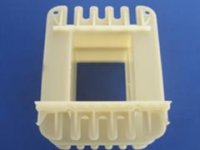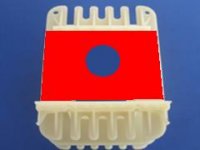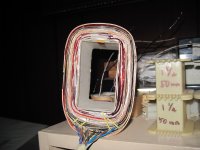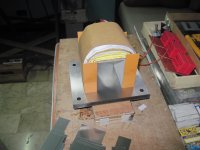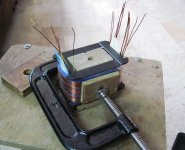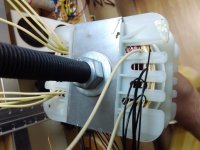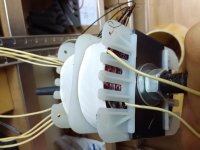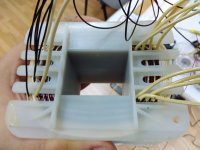Hello,
I have some limited access to a CNC coil winding machine and although I have learned its features, I tried winding a power transformer for a solid state amplifier of mine and I came across a major problem.
I am winding a relatively thick wire (1mm diameter) for the primary on a split bobbin like this one:
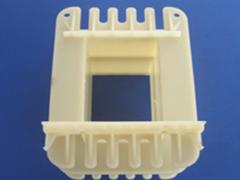
The main problem is - there is always an increasing gap between the wires of each successful layer, because the sides of the bobbin get more and more apart from the horizontal pressure of the wire. This widening is not equal through the bobbin's circumference. There is a bigger gap on the north and south sides than east and west. This results in the wire "falling" into the previous layer, resulting in an untidy, chaotic layer and things gets worse with each next layer that goes on top.
I tried watching some videos on youtube and I saw that almost all winders are clamping the bobbin using strong metal plates and if the bobbin is split, they put temporary blocks in the empty bobbin to apply clamping pressure from the other side.
So I tried building those, making also a thick steel plate (red colored on the photo) that would clamp the bobbin from the external side.
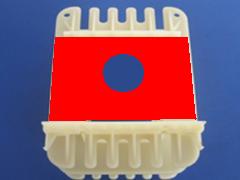
Although a little better, there is no way to clamp the "comb" edges and they get apart when I'm winding the final layers. This results in the wire falling into bottom layer at the "comb" area, but normally go on top at the clamped area.
There are compromises as options, such as applying a layer very thick insulation material between a few layers, when problems starts to appear. This will "reset" the winding pattern like if it was from scratch. I am using thin polyester sheet right now, but it's not sturdy enough.
The other option is to fill the gaps with some filling materials, such as cotton rope, but I find this slow and tedious , because I have to wind some more transformers and chokes.
I am sure I'm missing some very important details and I wonder how the ProS do it, but I cannot find any information.
I thank you in advance for any help!
I have some limited access to a CNC coil winding machine and although I have learned its features, I tried winding a power transformer for a solid state amplifier of mine and I came across a major problem.
I am winding a relatively thick wire (1mm diameter) for the primary on a split bobbin like this one:
The main problem is - there is always an increasing gap between the wires of each successful layer, because the sides of the bobbin get more and more apart from the horizontal pressure of the wire. This widening is not equal through the bobbin's circumference. There is a bigger gap on the north and south sides than east and west. This results in the wire "falling" into the previous layer, resulting in an untidy, chaotic layer and things gets worse with each next layer that goes on top.
I tried watching some videos on youtube and I saw that almost all winders are clamping the bobbin using strong metal plates and if the bobbin is split, they put temporary blocks in the empty bobbin to apply clamping pressure from the other side.
So I tried building those, making also a thick steel plate (red colored on the photo) that would clamp the bobbin from the external side.
Although a little better, there is no way to clamp the "comb" edges and they get apart when I'm winding the final layers. This results in the wire falling into bottom layer at the "comb" area, but normally go on top at the clamped area.
There are compromises as options, such as applying a layer very thick insulation material between a few layers, when problems starts to appear. This will "reset" the winding pattern like if it was from scratch. I am using thin polyester sheet right now, but it's not sturdy enough.
The other option is to fill the gaps with some filling materials, such as cotton rope, but I find this slow and tedious , because I have to wind some more transformers and chokes.
I am sure I'm missing some very important details and I wonder how the ProS do it, but I cannot find any information.
I thank you in advance for any help!
Attachments
I think the traditional insulation between layers is high quality paper. However, for 1mm wire you may need something stronger than paper.
use sheet of kraft paper in between layers and nomex paper in between coils.....
i also use bobbins and never had problems, it is up to you...
it takes lots of practice and actual experience......
i also use bobbins and never had problems, it is up to you...
it takes lots of practice and actual experience......
Attachments
Thanks. I'm getting better and better with practice. The wire behavior on a bobbin seems to be a huge art to learn.
I did some research on the internet and I found out the best way for direct insulationless winding is using the "orthocycle pattern". I tried practicing winding this way and I have a major success.

I did some research on the internet and I found out the best way for direct insulationless winding is using the "orthocycle pattern". I tried practicing winding this way and I have a major success.

I'm very happy. This is my 4th power transformer and there was no wire falling down the edges. I found out wire tension plays a very big role in "the trick" and it should be gradually reduced when the diameter of the bobbin gets increased.
I have wound an equivalent of 8kgs of copper wire so far in transformers and I have 1kg of scrap wire. 😀
The secret is to really "let it go" and learn from your mistakes.
Thanks for the tips.
I have wound an equivalent of 8kgs of copper wire so far in transformers and I have 1kg of scrap wire. 😀
The secret is to really "let it go" and learn from your mistakes.
Thanks for the tips.
Attachments
- Status
- Not open for further replies.
